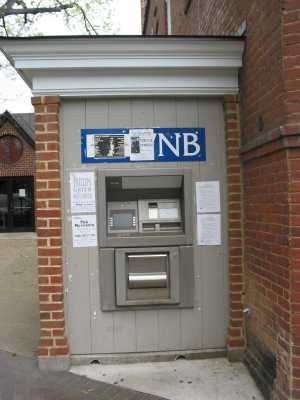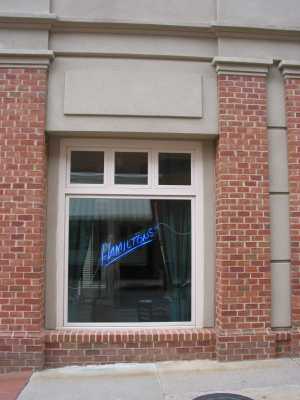|
|
|
|||||||||||



|
"Is it art, or is it crime? Even graffiti painters are conflicted. 'I try to make my work as high quality and pleasing-to-the-eye as possible, but sometimes it's not so easy,' wrote the person behind the 'Tom Hanks' graffiti that's taking over Albemarle County's urban ring. 'But I feel in the long run, the message outweighs the guilt. And, my work usually looks better than a drab concrete wall.' 'Tom Hanks,' not to be confused with the actor, and 'Barney Fife,' representing a group of about 15 graffiti stencilers, agreed to be interviewed via e-mall as long as they weren't identified. Between the ages of 17 and 22, the painters have caught area residents - and authorities' - eyes with their work in the last few weeks. The spray-painted stencils largely confined to the city limits, recreate the faces of mostly has-been celebrities. 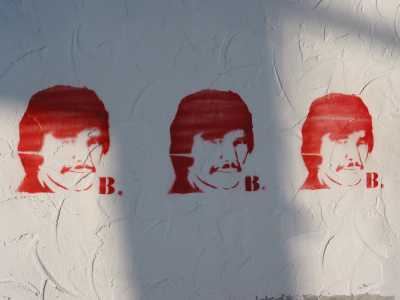 The roster includes: Bob Saget of 'Full House' and Funniest Home Videos' fame; former action-movie star Charles Bronson; ex-children's show host Pee Wee Herman; Don Knotts, the man behind 'Andy Griffith Show' deputy Barney Fife, and football player-acquitted murder suspect O.J. Simpson. Last year's stenciler of ape faces mimicking Roddy McDowall's Dr. Cornelius character from 'Planet of the Apes,' is not involved in the more recent stencils, Fife said. 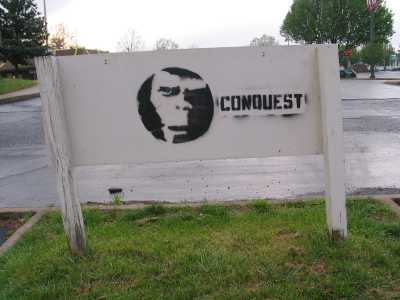 Hanks and Fife are friends with similar views on star worship. 'Not only is it mocking the constant obsession people have with celebrities and Hollywood, but it is also to give people a laugh,' Hanks wrote. 'So, on the way to someone's boring job they will think about why someone would put Bob Saget all around town. Or write Tom Hanks in 10-feet-tall letters. 'Hopefully it will inspire people to change their daily routine and do something out of the ordinary.' The paint police The graffiti has inspired some laughter, but among police, school officials and business owners, it's inspired aggravation as well. 'They got me,' said John Redman, manager of the Sherwin-Williams paint store on U.S. 29, a Tom Hanks victim. 'I like the guy and everything, but you don't need to do that.' Al Reaser, director of building services for Albemarle schools, knows a lot about ridding walls of graffiti. 'We try to deal with it within 48 hours, if it's reported,' Reaser said. Some schools are faster about reporting vandalism than others, he said. The theory behind clearing up graffiti quickly is that if it remains in one place long, it will draw more artwork, Reaser said. Last week, his department washed off two stencils of Charles Bronson from Albemarle High School's marquee. The turnaround was less than 24 hours. School maintenance workers have a three-stage cleanup plan: power-washing, then power-washing with a strong detergent and, if all else fails, the 'mini-sandblaster' treatment. Those are for the serious cases, such as graffiti on brick or other rough, porous surfaces, Reaser said. For bathroom scrawlings, which are far more common in Albemarle schools, maintenance workers just paint over the offending words. 'Relatively speaking, we don't have vandalism,' Reaser said. Bobby Thompson, the principal of Charlottesville High School, however, readily admits his school has graffiti. It's right outside for anyone to see. 'It's hard to break CHS tradition,' he said of the wall between the school and the Charlottesville Performing Arts Center, a large collage of colorful signatures, or tags, and, currently, a worshipful portrait of Britney Spears. 'It has been there forever,' said Ron Hutchinson, Charlottesville schools' assistant superintendent and a lifelong city resident. 'I couldn't even begin to tell you when that began.' When Thompson arrived at CHS nine years ago, he didn't think much of the wall. Now he'll reluctantly say that some of the artists are gifted, but the school still paints over the wall every summer. The graffiti always reappears by the first or second week of school under the cover of darkness, Thompson said. 'I think it's county kids as well as city kids that are doing it,' Thompson said, citing a Sunday last fall when he discovered some Albemarle teenagers with 30 cans of spray paint working on the wall. Thompson and other CHS employees keep a close eye on the wall, making sure there aren't any profanities on it. He said one positive factor of the wall is that it seems to limit the amount of graffiti elsewhere around the school, particularly on the inside. Charlottesville's neighborhood planning and development services is taking a similar tack, cleaning up only scattered graffiti, rather than the more established walls under the Avon Street bridge and at Eighth Street Northwest and Page Street. University of Virginia students even have their own forum at Beta Bridge. 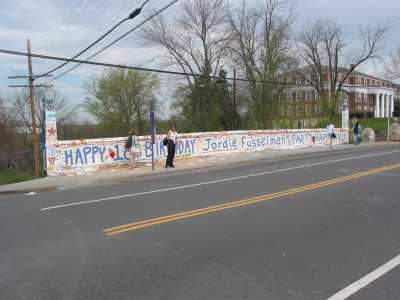 A new ordinance, established at the beginning of the year, cites property owners for graffiti removal, or the owner can ask neighborhood services to clean it up within five days at no cost. Since January, neighborhood services, working in conjunction with the city police, has removed graffiti from 100 properties, spending $5,000 in all, according to city officials. Albemarle police leave the cleanup to individual property owners and the Virginia Department of Transportation. Busting graffiti artists is a slippery business, said Crystal Limerick, Albemarle's acting police captain, because officers must catch the artists in the act to charge them for the misdemeanor offense. 'I'm not even sure if we've identified all of the places,' Limerick said, referring to the crop of Tom Hanks signatures. Street ethics Fife wrote that the stencilers pay attention to the surfaces on which they paint, trying not to cause too much trouble to authorities and business owners. 'No small businesses, no residential buildings, no religious buildings, no cars, etc.,' Fife wrote.
A friend of Hanks recently wrote 'Meg Ryan' on a truck, a graffito Hanks wished to distance himself from: 'I had nothing to do with that.' The celebrity graffiti artists also consider themselves different from the drawers of 'gang graffiti,' which is marked by tags and territorial insignia. 'None of our graffiti represents different neighborhoods, communities, gangs,' Hanks wrote. ''Gang graffiti is not artistic and has no meaningful message.' Why they write Peter Sheras, a UVa education professor who has studied youth violence, also makes a distinction between the two forms of graffiti. 'It occurs to me there are at least four reasons' teens and young adults paint graffiti, Sheras said.
The first is 'tagging,' which Sheras classifies as gang-related. Although the Charlottesville area doesn't have the organized drug dealing and high rate of murder associated with gangs, 'there are some gang-like groups,' Sheras said, and many of them have their own signs to mark territory. Thompson has noticed neighborhood logos on the CHS wall, particularly from the city's housing projects. Often, casual bystanders don't even notice the scrawled tags on signs, brick walls and telephone booths. 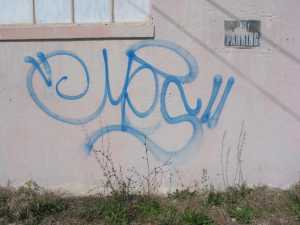 'Sometimes the signs are recognizable only to the initiated,' Sheras said. Other graffiti artists feel a need for recognition, particularly as teenagers. 'Adolescence is a time of constructing identity,' Sheras said. 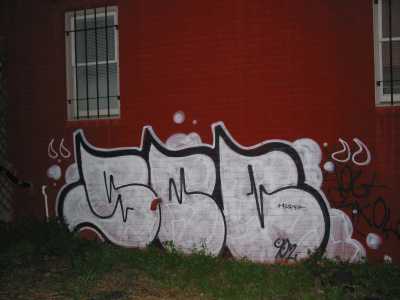 Another reason is self-expression, leading to what Sheras calls 'urban art.' 'For some kids, the blank space seems to call them,' he said ' adding that many 'urban artists' turn to more conventional, and legal, means of expression later. A fourth motivation is to vent frustration and anger, one of the reasons behind insulting graffiti, which can strike an unpopular student, a rival graffiti artist or an entire political party. As for the celebrity graffiti, Sheras said, 'I think it's probably adults who are doing that. It's not there to deface anything. It's there to advertise something.' If it is an advertisement, the product isn't clear, even to Fife and Hanks. 'People should take what they want from it,' Fife wrote. 'It may not
seem that important, but we hope in the long run it will make people realize
what is really important.'" (Kate Andrews, The Daily Progress, April
11, 2002)
|



